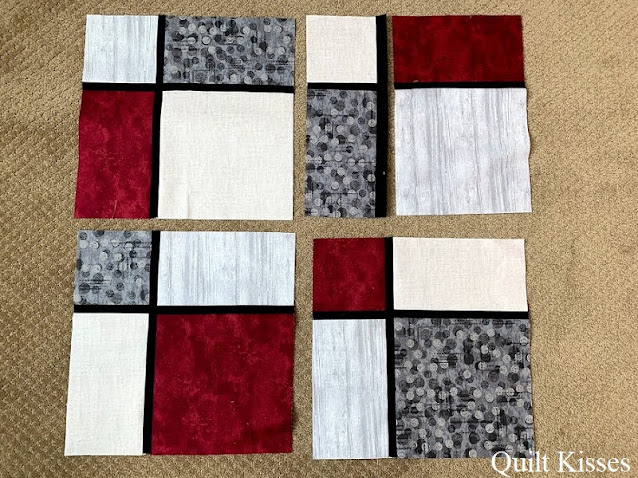This is the quilt top I made for my nephew T and his fiance S. He requested a maroon and gray quilt. He said that it would be really neat if I could design it after his favorite artist, Piet Mondrian. Mondrian's work is mostly primary colors in squares and rectangles with black lines separating them.
I decided to make the quilt in blocks and rows to simplify things. I didn't want any partial seams. I used a simple trick which I learned from Christina Cameli to make the block math easier. It you slice into a block and add a one inch wide strip, you don't change the size of the block at all. The one inch piece equals all the seam allowances.
I thought I would share my process here in case anyone would like to make a similar quilt.
I started by cutting out five 14 inch squares from each of the four fabrics. I put them all on my design wall. My plan was to make four each of five different blocks.
I cut the black out as I needed it to prevent fraying. I cut one fourteen inch WOF strip from the black fabric. Then I cross cut 42 one inch pieces. Four of them were cut down to 1 x 9 inch pieces. Then I cut six one inch by WOF strips for the sashing between rows. The border is seven 2 inch wide strips. The binding is seven 3 inch wide strips. (I like it extra wide when I have minky on the back.)
Block A is just a 14 inch square unfinished. So it was already done.
For block B, I cut one 14 inch square of each fabric in half. I mixed up the rectangles, and sewed one 1 x 14 inch black strip in the middle of each set. I always pressed towards the black strip.
There were two steps for Block C. I again cut one of each large square in half. Then I sewed one skinny strip between two 7 x 14 inch rectangles twice. (Using one of each fabric.)
Then I cut each of those pieced sets in half again. I added a plain 7 x 14 inch rectangle to three of them. I left one unsewn so that I could offset the blocks in the even numbered rows.
For block D I cut a five inch strip off of one of each large square. Then I added a skinny strip to sew the 5 x 14 inch rectangles to the 9 x 14 inch rectangles.
I once again cut a five inch strip from each set. I mixed them up, added a skinny strip, and got these four blocks. You can see that I didn't fully sew the upper right block together. That is to offset the even rows.
For block E I cut a five inch strip off of one of each large square. Then I cut the 9 x 14 inch rectangle in half to get two 7 x 9 inch rectangles each.
I sewed a 1 x 9 inch strip between the 7 x 9 inch rectangles. Then sewed a 1 x 14 inch strip between those sets and the 5 x 14 inch rectangles.
I put all of the blocks up on my design wall. Row 1 has four full blocks. Row 2 has three full blocks and the two partial block D pieces on each side. Row 3 has four full blocks. Row 4 has three full blocks and the two partial block C pieces on each side. Row 5 has four full blocks.
Because each pieced block is still 14 inches (unfinished size) you can place any block any where and rotate however desired. I moved the blocks around a lot.
It was a little hard to visualize the end product, so I pinned up some one inch strips to see if I liked the layout.
I wanted a slightly wider border, so I cut it out at 2 inches.
I love how the quilt top turned out. My art teacher sister said that she could definitely see the Mondrian influence. (She knew who he was. I had to look him up on the internet.)
This quilt is already finished, but I will share that in my next post. This one is already pretty long.
XX,
Jasmine

















Great tutorial! The only time I have use a 1" cut sashing is on the jean quilts. I really like this idea of cutting the blocks to make more block method you used here.
ReplyDeleteGreat quilt Jasmine! Looks like it would be fun to try this sometime, thanks for sharing your method.
ReplyDeleteI love that one inch strips keep blocks the same size; lovely method and tutorial!
ReplyDeleteThis quilt is a masterpiece. I think Mondrain would be impressed!!
ReplyDeleteWhat a special quilt you created for your nephew and his future bride! Thanks for sharing the design with us, Jasmine. This quilt DEFINITELY qualifies you for the Aunt of the Year award!
ReplyDeleteVery Modern Very Mondrian. It will look fresh and chic even after 20 years. I am sure they will love it and cherish it for a long time. Thank you for sharing the process pictures.
ReplyDeleteThis is really a fascinating quilt Jasmine! Thank you for taking the time to write out exactly what you did; that IS a cool math trick from Christina. Funny the horizontal sashing appears to be the same width even though I know it isn't. Must be what Angela says about the eye making things symmetrical!
ReplyDeleteLovely! Thanks for sharing your process. I'll remember that tip about 1" strips.
ReplyDelete